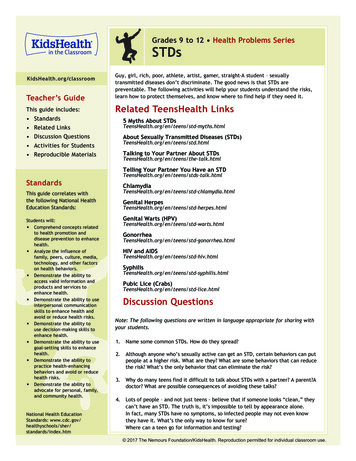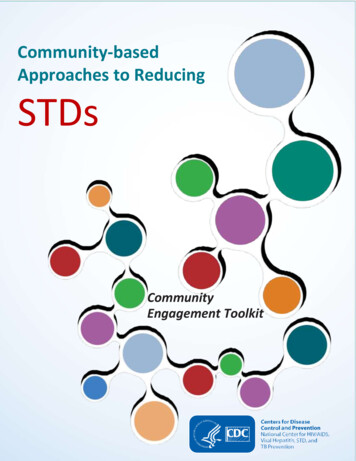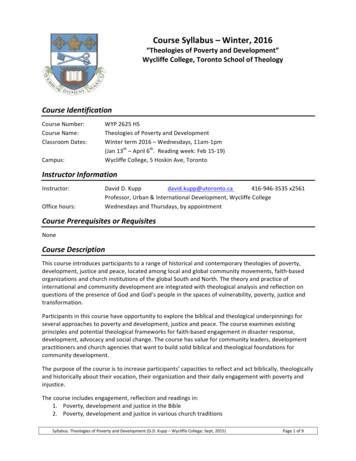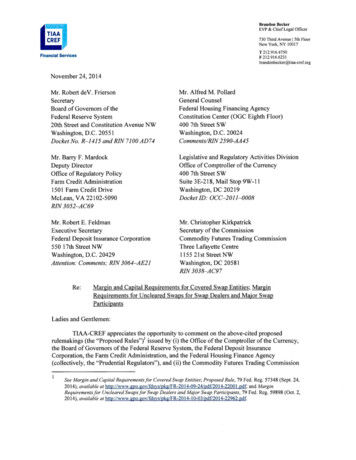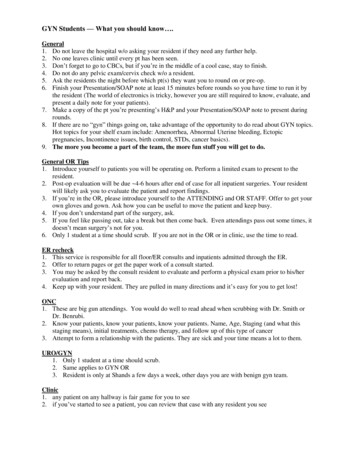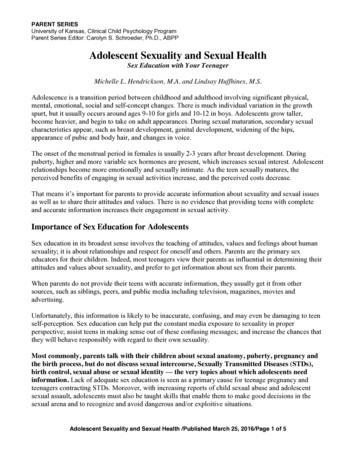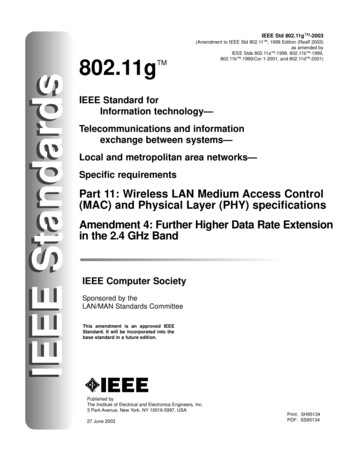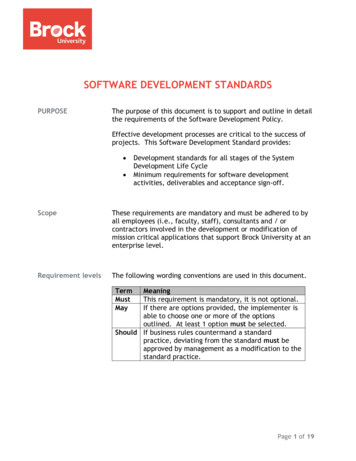
Transcription
SOFTWARE DEVELOPMENT STANDARDSPURPOSEThe purpose of this document is to support and outline in detailthe requirements of the Software Development Policy.Effective development processes are critical to the success ofprojects. This Software Development Standard provides: Development standards for all stages of the SystemDevelopment Life CycleMinimum requirements for software developmentactivities, deliverables and acceptance sign-off.ScopeThese requirements are mandatory and must be adhered to byall employees (i.e., faculty, staff), consultants and / orcontractors involved in the development or modification ofmission critical applications that support Brock University at anenterprise level.Requirement levelsThe following wording conventions are used in this document.TermMustMayMeaningThis requirement is mandatory, it is not optional.If there are options provided, the implementer isable to choose one or more of the optionsoutlined. At least 1 option must be selected.Should If business rules countermand a standardpractice, deviating from the standard must beapproved by management as a modification to thestandard practice.Page 1 of 19
Definitions,Acronyms andAbbreviationsAgile Method:A software development method. Most agile methods breaktasks into small increments with minimal planning and do notdirectly involve long-term planning. Iterations are short timeframes that typically last from one to four weeks. Everyiteration involves a cross-functional team working in all steps:planning, requirements/analysis, design, coding and testing. Atthe end of the iteration, a working product is demonstrated tostakeholders. This minimizes overall risk and allows the projectto adapt to changes quickly. Iteration might not add enoughfunctionality to be useable on its own, but the goal is to have anavailable release at the end of each iteration. Multipleiterations might be required to release a product or newfeatures.AODA:Accessibility for Ontarians with Disabilities Act – legislation.Application:Computer programs, procedures, rules and associateddocumentation and data pertaining to the operation of acomputer system.Audit or Review (Peer Reviews):An independent review to assess compliance with softwarerequirements, specifications, baselines, standards, procedures,instructions and code.Baseline:A specification or end-product that has been formally reviewedand agreed upon. This becomes the basis for furtherdevelopment and must go through change control procedures tobe altered.Software Development StandardsPage 2 of 19
BSA:Business System Analyst.CAB (Change Advisory Board):A cross functional group representing the various areas in ITS.This group reviews proposed changes to infrastructure, software,networking, firewall rules, etc.Cross-functional team:A group of people with different functional and technicalexpertise working together to achieve a common goal.DBA:Database AdministratorEvaluation:A technique in which requirements, design, code and test resultsare examined in detail by a person or group to detect potentialproblems. The results are documented.Incremental / Iterative Methods:Software development methods. This method breaks the projectrequirements into incremental changes (phases or sprints). Theseries of changes/releases is referred to as “increments”, witheach increment providing more functionality to the customers.After the first increment, a core product is delivered, which canalready be used by the customer. Based on customer feedback,a plan is developed for the next increments, and modificationsare made accordingly.Maintenance:To repair, change or enhance software/application.Software Development StandardsPage 3 of 19
Mission Critical:A system or application whose failure will result in the failure ofUniversity operations.MoSCoW method:A technique used to reach a common understanding withstakeholders on the importance they place on the delivery ofeach requirement. Also called the MoSCow prioritization oranalysis.LetterMeaningDescriptionMMustThe requirement MUST be satisfied in thefinal solution for the final solution to beconsidered a success.SShouldA high priority item that should be includedin the solution if possible. Often a criticalrequirement that may be satisfied in otherways if strictly necessary.CCouldThe requirement is considered desirable butnot necessary. It should be included in thesolution if time and resources permit.WWon’tA requirement that stakeholders haveagreed will not be implemented in a releasebut may be considered for the future.Product:A product is the tangible result of any process or work group.This includes (but is not limited to) purchased software products,components, code, services and deliverables.Project Team:A group of people (may include various departments) whocollaborate and work together to deliver a software product.Regression Testing:The process of testing changes to software to ensure the changeshave not adversely affected current system functionality.Sign-off:The declaration that the product has met expectations and beenaccepted by the governing body of the project.Software Development StandardsPage 4 of 19
Software Development Lifecycle (SDLC):A systematic approach to creating software applications. Thiscycle typically includes the following seven phases:1. Requirements gathering - collection of businessrequirements / needs2. Analysis - Business and requirements analysis3. Design - Architecture and application design4. Coding – Development/programming5. Testing – Quality assurance, bug fixes, error correction6. Implementation – Deploying (releasing) the applicationinto the production environment for business use7. Post Implementation – maintenance and review.System:A set of programs which perform all functionality defined withina software application.Subsystem:A functionally related to a subset of the system.User Acceptance Testing (UAT):UAT testing is performed by the functional business groups thatwill be using the software in production. It is performed on atest/ quality assurance site that is separate from the productionenvironment.Walkthrough:A review process in which an individual(s) leads their peersthrough their work product. This is used to evaluaterequirements, specifications, code, documentation, etc.Waterfall Method:A software development method. Waterfall is a sequentialdesign process. Each phase in the lifecycle must be fullycompleted, documented and agreed upon prior to movingforward to the next phase.Software Development StandardsPage 5 of 19
References andRelated DocumentsVersionTitleDocument LocationDateAccessed2.1Standards for ku.local\carddfs\develop\documentation\standards and cumentation\standards and L elop\documentation\standards and develop\documentation\standards and checklists11/11/2014dd/mm/yyyy1.21.0SQL templates forstored procedurecreationProductionEmergency Releaseto sioning and/ orChange ManagementRequested revisions to these Standards are to be submitted tothe Application Architect for approval.General StandardsAll software development projects, including maintenanceprojects, must follow these standards.Objectives for application development include: Clear definition of purpose Simplicity of use Ruggedness (difficult to misuse, kind to errorsencountered) Delivered on time and when needed Reliability Efficiency (fast enough for the purpose it was created) Minimum development cost Conform to standards Clear, accurate and precise user documentation Clear, accurate and precise technical documentation.All production systems must have designated Owners andCustodians for the critical information they process in order toidentify requirements and verify the final deliverables withsignoff.There must be a separation between the production,development and test environments. This will ensure thatsecurity is rigorously maintained for the production system,Software Development StandardsPage 6 of 19
while the development and test environments can maximizeproductivity with fewer security restrictions. Where thesedistinctions have been established, development and test staffmust not be permitted to have access to production systems.All applications are reviewed at predetermined checkpoints ofthe SDLC by the Application Architect or their designate. Anydeviations are reported and corrective action is determinedprior to the application being released to production.Electronic authorization indicating Standards have been met isrequired before a new or modified application can be releasedto production.Throughout the entire project, special consideration must begiven on an ongoing basis to capturing and implementingsecurity and privacy requirements. The post-implementationreview must reflect this.RequirementsGatheringDocument a clear statement of the current situation outliningproblems and opportunities the software will address.Review existing systems/processes.Identify and document the issues with the current data/system/ process.Document: New business needs New assumptions since initial project assessment Items that will not be solved with this software(outstanding issues) Integration points with other software Data storage requirements Data retention requirements Cross-functional support/input required to proceed withthis project/request uirements Confidential data, access rights to this data andcompliance requirements for this data (e.g., paymentrequirements must meet PCI compliance; student homeaddress must adhere to FIPPA rules, etc.) Roles required for security.Software Development StandardsPage 7 of 19
Logging requirements (i.e., what needs to be captured inaudit logs other than who updated, when updated, etc.).Reporting requirements.Training requirements.Walkthrough and review of requirements: Walkthrough with client Walkthrough with peer.Obtain sign-off and approval from client to ensure there isagreement on the requirements as documented.Deliverables: Requirements document.AnalysisEvaluate the documented requirements. During the evaluationprocess the following criteria must be considered and results ofthe evaluation documented: Requirement can be traced to business need Requirement is consistent with business need Testability of the requirements Can the requirement be implemented given the currentarchitecture?Establish and document software requirements: Functional and capability specification, includingperformance and design characteristics andenvironmental conditions under which the software is toperform Interfaces external to the software module/ component/service Testing requirements Privacy and security specifications Data definition and database requirements User acceptance and implementation requirements forthe delivered application, including:o Will data validation from loads/migrations berequired?o Test results required for quality acceptanceo Test results required for performance acceptanceo How will ease of use/efficiency be measured?Operation and execution requirements: How often will the application be accessed?Software Development StandardsPage 8 of 19
Does this application rely on the existence of anothermodule/ data?Storage needs and potential growthWhat tools or technologies will users need to access thesystem (e.g., VPN, special licensing, etc.)?Maintenance requirements.Walkthroughs and reviews: Architecture checkpoint review Internal peer reviews.DesignDocument the following: Identify tasks, pages, reports, procedures and functions Identify common modules that will be used Define the control logic for each task and unit Identify database and access requirements Identify feeds into the system module (including thosecoming from other sources) Identify exports and outputs from this system/module Assess performance requirements Define backup / recovery requirements Define the "hows" for each process rule and edit itemidentified in the analysis. These will become the logicdescriptions in detailed design Define exception handling Conduct session(s) with architects (application and dataarchitects) to review and flesh out design requirements Conduct final design walkthrough Document testing considerations: these requirementsinclude identifying data files accessed, tests and startupconsiderations Define how the user will access the system/modulesDeliverables: Design document Project work schedule Coding specifications to be given to developers Transitional documentation for operations group (formatTBD).Software Development StandardsPage 9 of 19
Coding/DevelopmentSQL and .Net are the standard development platforms forenterprise applications.Stored procedures/functions are required for all Databaseaccess (server side). Client side coding is kept to a minimumand only used if approved by Application Architect and BusinessSystems Analyst. This is a security measure used to preventinfusion attacks.All code must be written with the following goals in mind: Maintainability; adaptable to cope with changingrequirements. The following questions will help judgethe maintainability code:o Can I find the code that is related to a specificproblem or change?o Can I understand the code? Can I explain therationale behind it to someone else?o Is it easy to change the code? Is it easy for me todetermine what I need to change?o Can I make a change with only a low risk ofbreaking existing features?o If I do break something, is it quick and easy todetect and diagnose the problem? Dependability. Does the code meet its specification,i.e., "correct output for each possible input"Efficiency. Is the program efficient enough for theenvironment in which it is used?Usability.New stored procedures must include all the elements in the SQLtemplate. Templates are located in the department share (seeReferences and Related Documents for location).Functions must be authorized and created by a DBA. Functionscan be resource intensive depending on use so require a DBA toensure efficiency and that their use is warranted.Triggers must be authorized and created by a DBA. Triggers canbe resource intensive depending on use so require a DBA toensure efficiency and that their use is warranted.User controls must be created/maintained by a DevelopmentTeam Lead(s).Comments/tracking: each code module must contain: Name of the moduleSoftware Development StandardsPage 10 of 19
Purpose of the moduleBrief description of the moduleOriginal authorOriginal implementation dateChange control list which identifies:o Date of changeo Who authored the changeo Footprint ticket or project number that initiatedthe request for changeo Description of changeo Sample execute statemento In-line comment of variables at declaration toidentify purpose and useo In-line comment blocks to describe requiredfunctionality for code when logic is complicated ormore involved than usual. This adds tomaintainability, allowing others to quicklyunderstand what is happening in the logic.Create / update unit tests documentation (at minimum) formodules/ features.Create / update help documentation associated with thechange to the module/ feature.Create/update technical documentation associated with thechange to the module/ feature.Naming conventions must be adhered to.Code portability is a goal. Hard-coding is to be avoidedwhenever possible (it is recognized that in some cases this isunavoidable). Should hard-coding be unavoidable, it must beidentified and reviewed with the Business Analyst for approval.The approval must be documented as part of the projectdocumentation.All development must complete a code walkthrough prior tobeing promoted to QA/Production. Walkthroughs shouldinclude: BSA and a Team Lead. DBAs should be included forcomplex SQL or when processing times need to be reviewed.AODA requirementsAll new systems/pages/reports implemented must adhere toAODA standards. An AODA checklist exists (refer to theSoftware Development StandardsPage 11 of 19
References and Related Documents section above for thechecklist location).SQL & .NET codingstandardsTemplates exist for SQL procedures (insert, update, delete,select). These templates include code that must exist in allSQL procedures used for data retrieval/update. Applicationsession information is required to identify who is retrieving/updating/ deleting data. Procedures used to fill screen dropdown lists do not require session information when the dataretrieved is not sensitive. For example, a procedure whichreturns a list of valid academic sessions or valid coursedurations or valid subject codes would not need to have sessioninformation as this is public information.For batch procedures special coding is used to identify a batchrun.TestingEach software change requires testing. The degree of testingwill vary depending on the size and complexity of the change.Each test must be supported by documentation. For simple,low risk changes, this may take the form of screen shotscaptured and put into a Word document.At minimum, there must be a document identifying what wastested and signed off by an analyst and the primary userindicating the change was successfully reviewed and testedprior to implementing to QA and production.Testing for AODA compliance is required for pages/reports.Consult/Include Operations staff in the test phase for transitiontraining.Document your testIdentify the type of test you are performing: Unit testing Regression testing Load testing User acceptance testing.Software Development StandardsPage 12 of 19
Identify the functionality/features being tested. Identify thefunctionality/ features NOT tested for clarity.Identify who is required to participate in the testing their rolein testing. Consider: Analyst Developer Client/user Other (e.g., DBA, ISSG, Client Services).Identify what needs to be in place before testing can begin: Is there specific hardware that is required, or a specificconfiguration that needs to exist? Is there software required for this testing? Does data need to be loaded/set up?Identify the Pass/Fail criteria for each item tested: Steps / schedule of activities: identify tasks anddependencies between the tasks.Deliverables: Completed AODA checklist. Test logs: Show items tested with inputs and resultingoutputs. This should be derived from the test cases thatwere identified and documented in thecoding/development phase. Issues Log: Record issues encountered during testing andcorrective action taken. Summary: brief summary of results, metrics and anyobservations during testing, including participant input. Approvals and sign-offs:o To validate the system/change has been testedthoroughly, sign-offs from the Business SystemsAnalyst, system owner and any other testers arerequired.DocumentClearly define communication plan:implementation plan Communication plan to user community of newfunctionality Communication plan internally to ITS groups requiredto support the product. Identify and communicatewhat constitutes post-implementation support vs.Software Development StandardsPage 13 of 19
operational support to the project team and users ofthe system. This includes but is not limited to:o Change Advisory Board (CAB) need to be notifiedof the impending implementation (when and whatis impacted)o Operations group for ongoing support of theproducto ISSG to ensure proper backup/recovery processesare in place when production is liveo Client services, so they are aware of new/alteredfunctionality and potential impact to the BrockUniversity community.Clearly identify dates for implementation (i.e., if phases exists,each phase’s implementation date).Clearly identify tasks required to get the product implemented: Who is required to perform each task The order in which tasks must be completed, includingall dependencies Identify risks:o Involved with the implementationo If the implementation is not performedo Contingency plans associate with the risks.Identify all data imports required Are imports to be scripted or manually applied and bywhom.Identify system configuration required before the product canbe used in a live environment. Consider: Security roles Secure document/file repositories Scheduled backups.Training: What training is required for the users of the system? Who will do the training?Validation: Who will validate system functionality once the producthas been implemented? Who will validate data accuracy once the product hasbeen implemented? Identify scripts or procedures to perform validations.Software Development StandardsPage 14 of 19
Define the length of the post-implementation phase: 4 weeks can be used as a rule of thumb on largeprojects (1 year in duration) or complex projects.Adjust accordingly for smaller projects. For shorterduration projects, 1 or 2 weeks should be sufficient The post-implementation phase is supposed to give theuser time to use all features and functions whileresources are available to support any unforeseenissues.Go Live DecisionEnsure the project team and primary user contact/primarystakeholders are in agreement with the implementation plan.Ensure the primary user contact/primary stakeholders agreewith all that has been completed and tested.Get agreement to move to production.Deliverables: Implementation plan document Transitional documentation for operations group(format TBD).PostImplementationThe post-implementation time is typically referred to as astabilization period. Resources are still assigned to the project,typically with a lower percentage of time allowance, andavailable to make adjustments if issues arise.Any work done at this point is to ensure the functionality andfeatures that were in scope as outlined in the charter,requirements, specification and design are working asexpected.Changes to functionality and features are not part of thisprocess, they would require a new project or enhancementrequests be initiated through regular channels.Maintain a log ofissuesIdentify the priority level of each issue (to be done inconsultation with the system user and project team): Level 1: assign to team member(s) to resolve as part ofthe post-implementation of the project. This level canSoftware Development StandardsPage 15 of 19
be further broken down to prioritize the sequence towork on if multiple issues exist with this priority level.Level 2: create Footprint tickets to be handled as partof the Operations team’s regular mandate.Ensure Operations team is kept aware of the issues log.Prepare a project closing report identifying lessons learned andmilestones.Hold project close meeting and obtain signature on completionof report to close project.Deliverables: Issues and resolution log. Project close report.TemplatesTemplates for creating SQL procedures are to be used to createnew routines. These templates are shells set up to includebasic standards such as routine naming convention, commentblock and application session coding.Specifications /Requirementschecklist Was thought given to the system administrationfunctionality? Was thought given to error handling? Does the specification clearly divide the project intophases? Do all the phases have verifiable (and preferablyundisputable) outcomes? Does the document refer to any related documents asspecifically as possible? (Document title, revision, pagenumber)?If there are interfaces: Have the necessary data required for interfacing beenidentified? Is the maximum load (data and system usage) estimated? Are the security requirements specified? Are the operation and maintenance requirements specified(service transition)? Are the education/training requirements specified?Software Development StandardsPage 16 of 19
Are the installation/migration requirements specified?Has there been a peer-to-peer review (walkthrough)?Has the application architect reviewed (walkthrough)?Have the requirements/specifications been agreed to andsigned off by the user? Have reporting requirements been clearly identified?Design checklist Is the design as simple as it can be? Are all the functions/features that are listed in therequirements covered? Are all assumptions, constraints, design decisions anddependencies documented? Have all reasonable alternative designs been considered,including not automating some processes in software? Does the design have features or functionality which werenot specified by the requirements (e.g., are all parts of thedesign traceable back to requirements)? Does the design create reusable components if appropriate? Are modules well-defined including their functionality andinterfaces to other modules? Interface details: Routine name, parameters and their types, returntype, pre- and post-condition, usage protocol withrespect to other routines File name, format and permissions Are all major data structures described and justified? Are major data structures hidden with accessfunctions/procedures? Is the database organization and content specified? Are all key algorithms described and justified? Are all major objects described and justified? Is the user interface modularized so that changes in it won'taffect the rest of the program? Is a strategy for handling user input described, i.e., fileinput, manually entered through filters, etc. Are key aspects of the user interface defined? Are space use estimates and a strategy for spacemanagement described and justified? Is a strategy for handling I/O described and justified?Software Development StandardsPage 17 of 19
Is a coherent error-handling strategy included? Are error messages managed as a set to present a clean userinterface? Are necessary buy vs. build decisions included? Is this designed to accommodate changes/enhancements infuture? Is any part over- or under-designed? Are the major system goals clearly stated? Does the complete architecture fit togetherconceptually? Is the top-level design independent of the machineand language that will be used to implement it? Are you, as a programmer who will implement the system,comfortable with the design? Design review and Walkthrough completed with architects(data and application) Instructions/documentation for transition to OperationsteamDevelopment /Coding checklist Does every input that comes from an untrusted source (i.e.,typing into fields on a page, external systems) haveassociated error checking accounted for? Are all forms of validation done on the server side? (onlyallow on the client side on an as needed basis) Stored procedures used as the method for datavalidation/delivery Is each coding module of sufficient size? Limit the size forreadability and maintainability. Use a 4 page rule ofthumb. If the module is larger than 4 pages consider if itcan be reduced in size or functionality can be split out; alsoconsider the following: Size and quantity of data that would need to be passedbetween routines Number of temporary tables that would be needed Any extra database reads/writes that would be required.Does the code have the following: Proper naming convention Purpose is documented Brief descriptionSoftware Development StandardsPage 18 of 19
Original author and date are identified Change control area showing date of change, reason, personwho did it and associated project or ticket number Sample execute Unit test documented and repeatable Sufficient commenting exists throughout the code to makeit readable and understandable (i.e., maintainable) and thecomments match the actual code.Testing AODA requirements have been tested (see AODA checklist)Test case(s) have been identifiedPass/Fail criteria has been identified for each test casePage/Report filters Data entered in filters is trimmed Each valid option is tested for each filter Invalid data entered to test error control Test security by changing rolesSoftware Development StandardsPage 19 of 19
3djh ri 62)7: 5( '(9(/230(17 67 1' 5'6 385326( 7kh sxusrvh ri wklv grfxphqw lv wr vxssruw dqg rxwolqh lq ghwdlo wkh uhtxluhphqwv ri wkh 6riwzduh 'hyhorsphqw 3rolf\
